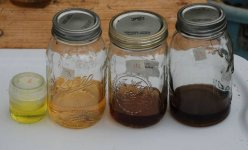Hey Gray Wolf!
Again I am delighted with this photo, excellent color of solution!
It is a pity a little bit that there is no photo "before" for comparison.
How many percent weighed remote "paint"?
Please, you will tell in more detail about this procedure and or properties of the applied materials. It is very interesting!
PS
Such success deserves the separate special detailed illustrated report, much more valid, than a mention of it casually.
It would be very interesting to see photos not only solutions, but also the dried-up extracts "before / after", with the indication of their scales.
Here are pictures of the next whole run. The procedure involves pouring the oil, dissolved in hexane, through a column of chromatography beads to strip out the polar elements.
Included is a smaller picture showing only four of the key extracts.
After the non polar elements are collected, the column is flushed with a polar solvent, which releases all the polar elements and flushes them through. The last couple of pictures are from the polar flush and the lighter ones are the goodies.
A GC run verified that the cannabinoids are in the light extractions and the darker elements are cannabinoid free.
Alas, I'm waiting to publish the study until Oregon Medical Growers finishes packaging their proprietary column mix, and is ready to deliver product.
We mixed the beads with hexane and poured them in the column, before applying 100psi air pressure to compact them. They are then ready to drain the hexane out and ready to use.
I am planning a complete writeup, as soon as folks have some place to go for the columns. I'm pushing a little to speed things up, but am not in charge or in a position to control the schedule.





